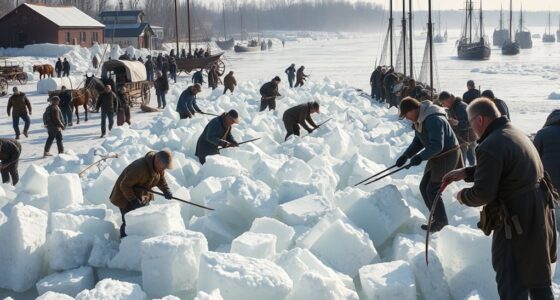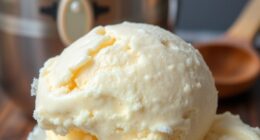Before freezers, making ice cream involved creative, manual methods like hand-cranked churns that kept ingredients moving to guarantee a smooth texture. People also used salt and ice layered in large containers to lower the temperature, enabling ice cream to freeze gradually. These traditional techniques relied on simple science and resourcefulness, often turning into social gatherings. Curious about how these clever methods worked and the fun behind them? There’s more to discover below.
Key Takeaways
- Hand-cranked churns with paddles manually mixed ingredients to achieve a smooth texture.
- Salt and crushed ice were layered around the mixture, lowering the freezing point for faster freezing.
- Continuous churning kept ice crystals small and prevented large ones, ensuring creaminess.
- Insulating materials like hay or cloth helped maintain cold temperatures longer during freezing.
- These methods were accessible, social, and relied on simple science and ingenuity before electric freezers.

Before the invention of modern freezers, making ice cream was a hands-on process that relied on ingenuity and simple tools. You didn’t just turn on a machine; instead, you engaged in a careful, sometimes laborious activity that required patience and skill. One popular method involved hand cranked churns—metal or wooden barrels with a handle you manually turned. You’d fill these churns with a mixture of cream, sugar, and flavorings, then seal them tightly. As you cranked, the paddle inside would rotate, breaking up ice crystals and mixing the cold ingredients evenly. This manual effort was essential because it kept the mixture moving, preventing large ice crystals from forming and ensuring a smooth, creamy texture.
Alongside hand cranked churns, the salt and ice method was the most common way to freeze ice cream. You’d start by layering crushed ice and coarse salt in a large container, creating a super-cold environment. The salt lowers the freezing point of ice, so the mixture inside the churn would freeze faster and more efficiently. You’d then place the filled churn into this icy blend, making sure it was surrounded on all sides. As you turned the handle, the cold from the salt and ice would work its magic, gradually transforming the liquid mixture into ice cream. The process required frequent attention—adding more salt and ice as needed and turning the churn steadily—because maintaining the right temperature was essential for achieving the desired consistency.
This method was both practical and resourceful, relying on readily available materials. The salt and ice method was especially popular because it allowed families and small shops to produce ice cream without specialized equipment. It was a communal activity, often done with friends or family, turning the task into a social event. The manual labor involved in turning the handle and managing the salt and ice was a small price to pay for the sweet reward of homemade ice cream. Interestingly, some even used insulating materials like hay or cloth to help maintain the cold environment longer. While it demanded effort and attention, this old-fashioned approach exemplifies the ingenuity of people before the age of electric freezers, showing how they used simple science and clever techniques to satisfy their sweet tooths.
Frequently Asked Questions
How Did People Store Ice Before Modern Refrigeration?
You might wonder how people stored ice before modern refrigeration. They relied on ice harvesting from frozen lakes and rivers during winter. They used ice storage techniques like ice houses, which kept ice insulated with straw or sawdust to prevent melting. This way, they could preserve ice for months, ensuring coolness for food and drinks even in the heat, all without the modern refrigeration we have today.
Were Any Specific Ingredients Used in Early Homemade Ice Cream?
Imagine crafting a treat as delightful as the Garden of Eden’s bounty. Early homemade ice cream often featured natural flavorings like fresh fruit, herbs, or vanilla. Dairy wasn’t always available, so people used dairy substitutes like coconut milk or almond milk. These ingredients helped create rich, invigorating desserts, showing that even before freezers, ingenuity turned simple ingredients into something truly special for the palate.
How Long Could Ice Be Preserved Without a Freezer?
You wonder how long ice could be preserved without a freezer. Using ice storage techniques, people relied on historical preservation methods like insulated icehouses and thick, cool earth pits to slow melting. These methods could keep ice intact for days or even weeks, especially in cold climates or winter months. Proper insulation and minimal exposure to heat were vital, extending ice’s usability and enabling refrigeration-like storage long before modern freezers existed.
What Tools Did Ancient Ice Cream Makers Use?
You see, ancient ice cream makers relied on hand-cranked churns to mix the ingredients thoroughly, creating a smooth texture. They used natural insulation, like straw or hay, to keep the mixture cold and slow melting. These tools worked together, turning and insulating, to produce delicious ice cream without modern technology. This clever combination allowed them to craft frozen treats efficiently, showcasing their ingenuity and resourcefulness.
Did Different Cultures Develop Unique Ice Cream Traditions?
You’ll find that different cultures did develop unique ice cream traditions, reflecting their cultural flavor profiles and traditional serving methods. For example, the Chinese enjoyed snow-flavored treats, while the Arabs created sorbets with exotic spices. In Italy, gelato became a beloved tradition. These diverse methods showcase how each society infused their unique tastes and customs into their frozen desserts, creating a rich tapestry of global ice cream traditions.
Conclusion
Before modern freezers, people relied on clever techniques like ice pits and hand-cranked churns to make ice cream. Did you know that in the 19th century, some methods could produce up to 10 gallons of ice cream in just a few hours? These innovative approaches show how resourceful our ancestors were. Next time you enjoy a scoop, remember the fascinating history of ice cream making—long before refrigerators made it easy!










